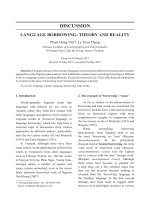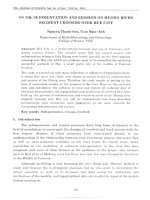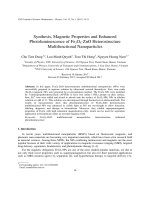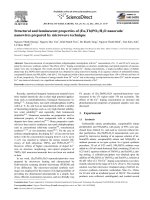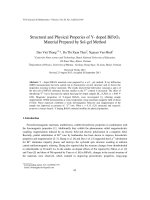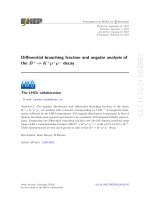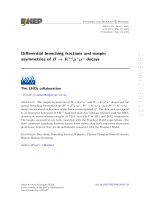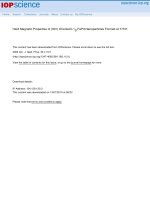DSpace at VNU: Structural, magnetic, Mossbauer and magnetostrictive studies of amorphous Tb(Fe0.55Co0.45)(1.5) films
Bạn đang xem bản rút gọn của tài liệu. Xem và tải ngay bản đầy đủ của tài liệu tại đây (307.21 KB, 12 trang )
Home
Search
Collections
Journals
About
Contact us
My IOPscience
Structural, magnetic, Mössbauer and magnetostrictive studies of amorphous
Tb(Fe0.55Co0.45)1.5 films
This content has been downloaded from IOPscience. Please scroll down to see the full text.
2000 J. Phys.: Condens. Matter 12 8283
( />View the table of contents for this issue, or go to the journal homepage for more
Download details:
IP Address: 132.174.255.116
This content was downloaded on 02/10/2015 at 23:40
Please note that terms and conditions apply.
J. Phys.: Condens. Matter 12 (2000) 8283–8293. Printed in the UK
PII: S0953-8984(00)15123-9
Structural, magnetic, M¨ossbauer and magnetostrictive studies
of amorphous Tb(Fe0.55 Co0.45 )1.5 films
N H Duc† , T M Danh†, H N Thanh†, J Teillet‡ and A Li´enard§
† Cryogenic Laboratory, Faculty of Physics, National University of Hanoi, 334 Nguyen Trai,
Thanh Xuan, Hanoi, Vietnam
‡ Laboratoire de Magn´etisme et Applications, GMP–UMR 6634, Universit´e de Rouen,
76821 Mont-Saint-Aignan, France
§ Laboratoire de Magn´etisme Louis N´eel, CNRS, 38042 Grenoble Cedex 9, France
E-mail:
Received 3 July 2000
Abstract. Films with a nominal composition of Tb(Fe0.55 Co0.45 )1.5 were fabricated by rfmagnetron sputtering from a fixed target configuration at various Ar gas pressures. Samples
were investigated by means of x-ray diffraction (XRD), scanning electron microscopy (SEM),
vibrating sample magnetometer (VSM), conversion electron M¨ossbauer spectra (CEMS) and
magnetostriction measurements. As the Ar pressure increases, the Tb and Fe content increases
slightly, whereas the Co content decreases. In addition, a small amount of Ar is introduced into
the films. The as-deposited films are amorphous alloys, but their magnetic behaviour depends
strongly on the deposition conditions: a perpendicular magnetic anisotropy is obtained only in film
deposited at lowest Ar pressure and a parallel magnetic anisotropy exhibits in remaining films.
These samples show an intrinsic magnetostriction (λ ≈ 10−3 ) in an applied field of 0.7 T. In this
state, it was determined that the hyperfine field reaches the value Bhf = 24.5 T. Effects of the heat
treatment on the magnetostrictive softness are also reported. The parallel magnetostriction with a
huge magnetostrictive susceptibility (χλ = 1.8 × 10−2 T−1 ) obtained at (µ0 H = 10 mT) makes
these materials useful for applications.
1. Introduction
Giant magnetostrictive materials in thin film form are very useful for microactuator
devices [1–4]. For these applications, large low-field magnetostrictive susceptibilities,
(χλ = dλ /d(µ0 H ) > 2 × 10−2 T−1 ), and low coercive fields (µ0 HC
100 mT), are
required [5]. Research on these materials, thus, concentrates on reducing the necessary driving
magnetic fields. Different approaches have been taken based on amorphous (Tb, Dy)(Fe, Co)2
asperimagnets [6, 7]. In these alloys, the R–FeCo exchange energies are stronger than
those in the ‘pure’ a-RFe and a-RCo alloys. This was thought to be the reason for the
closing of the cone type distribution of (Tb, Dy) moments, then the enhancement of the R
moment at room temperature and thus the magnetostriction. Recently, we have studied the
magnetization and magnetostriction in the amorphous (Tb, Dy)(Fe, Co)2.1 thin films [6, 7].
Indeed, a magnetostriction of 1020×10−6 was obtained in the applied field of 2 T for amorphous
Tb(Fe0.45 Co0.55 )2.1 [6]. The optimization of magnetostriction and ordering temperature has
been reported for TbDyFe/Nb multilayers by combining the advantages of a crystallized film
Corresponding author.
0953-8984/00/388283+11$30.00
© 2000 IOP Publishing Ltd
8283
8284
N H Duc et al
Figure 1. Dispersive x-ray energy for the Tb(Fe0.55 Co0.45 )1.5 film. The peak of Ar is obviously
recognized.
(high TC and giant λ) with soft magnetic properties of an amorphous phase [5]. In these
materials, however, the coercive fields were raised (µ0 HC ≈ 100 mT). In principle, it is well
known that the richer the rare-earth compound, the larger the spontaneous magnetostriction
is. Thus, another optimization of room-temperature magnetostriction can also be obtained
by combining the rare-earth composition and their ordering temperature. In view of this,
the crystallized R–Fe alloys with the greatest potential to achieve large room temperature
magnetostrictions are the cubic Laves phase RFe2 compounds [8], whereas the amorphous
ones are the RFe1.5 alloys [9, 10]. In addition, it is also expected that similar effects of the
substitution of Fe by Co on the enhancement of the magnetostriction found for 1:2 thin films
would also be observed for this 1:1.5 amorphous phase [6, 11].
In this paper, we studied the structure, magnetization, M¨ossbauer spectra and
magnetostriction of the amorphous films with a nominal composition of Tb(Fe0.55 Co0.45 )1.5
fabricated in different Ar gas pressures. Annealing effects make these films magnetically soft
and, thus, useful for applications.
2. Experiment
The films with a nominal composition of Tb(Fe0.55 Co0.45 )1.5 were fabricated by rf-magnetron
sputtering from a fixed target configuration at various Ar gas pressures. The typical power
during sputtering was 400 W and the Ar gas pressure was around 10−2 mbar. A composite
target consisted of 18 segments of about 20 degrees, of different elements (here Tb, Fe, Co).
The substrates were glass microscope cover-slips with a nominal thickness of 150 µm. Both
target and sample holder were water cooled. The thickness was measured mechanically using
an α-step. The film thickness was ranging from 0.5 to 1.2 µm without any coating. The film
composition was determined by energy-dispersive x-ray (EDX) (figure 1) and microstructure
investigation (figure 2) was performed using a scanning electron microscope. The film structure
was investigated by x-ray θ –2θ diffraction (XRD) with Cu Kα rays. The results showed the
as-deposited samples to be amorphous (figure 3).
Samples were annealed at temperatures from 250 to 450 ◦ C for 1 hour in a vacuum of
5 × 10−4 mbar in order to relieve any stress induced during the sputtering process. Subsequent
Tb(Fe0.55 Co0.45 )1.5 films
8285
(a)
(b)
Figure 2. Micrograph for films A: (a) as-deposited and (b) annealed at 350 ◦ C.
8286
N H Duc et al
Figure 3. X-ray diffraction patterns of film A.
x-ray θ–2θ diffraction showed no evidence for a global crystallization after annealing, but the
peaks of Tb oxides and α-(Fe, Co) appear due to the surface oxidation, see also figure 3.
The magnetization measurements were carried out using a vibrating sample magnetometer
(VSM) in a field of up to 1.3 T at 300 K.
The conversion electron M¨ossbauer spectra (CEMSs) at room temperature were recorded
using a conventional spectrometer equipped with a home-made helium-methane proportional
counter. The source was 57 Co in a rhodium matrix. The films were set perpendicular to the
incident γ -beam. The spectra were fitted with a least-squares technique using a histogram
method relative to discrete distributions, constraining the line-widths of each elementary
spectrum to be the same. Isomer shifts are given relative to α-Fe at 300 K. The average
‘cone-angle’ β between the incident γ -ray direction (being the direction normal to the film)
and that of the hyperfine field Bhf (or the Fe magnetic moment direction) is estimated from
the line-intensity ratios 3:x:1:1:x:3 of the six M¨ossbauer lines, where x is related to β by
sin2 β = 2x/(4 + x).
The magnetostriction was measured using an optical deflectometer (resolution of
5 × 10−6 rad), in which the bending of the substrate due to the magnetostriction in the film
was measured [12, 13].
3. Experimental results and discussion
Four samples, named A, B, C and D, were deposited from a fixed target configuration, but with
different Ar gas pressures (ranging from 5 to 15 mbar, see table 1). The resulting thickness,
composition and Ar contamination are summered in table 1. It can be seen from this table
that as the Ar gas pressure increases, the deposition rate and the Co content decrease, whereas
only a weak increase is observed for the Tb and Fe content. These composition variations can
be understood by the difference in the scattering of sputtered Tb, Fe and Co particles [14].
Tb(Fe0.55 Co0.45 )1.5 films
8287
Table 1. Sample characterization of Tb(Fe0.55 Co0.45 )1.5 films.
Samples
Thickness
(µm)
Ar gas
pressure
(mbar)
Deposition
rate
(nm min−1 )
Tb
content
(%)
Fe
content
(%)
Co
content
(%)
Ar
content
(%)
A
B
C
D
1.15
0.7
0.5
0.6
5
8
10
15
3.5
3.1
2.7
2.4
40.4
40.6
40.8
41.2
32.0
32.2
32.6
32.6
27.0
26.4
25.6
25.0
0.6
0.8
1.0
1.2
Moreover, as indicated by the EDX results (figure 1), a small amount of Ar atoms is introduced
into the films. This Ar content increases with increasing Ar gas pressure.
The magnetic hysteresis loops measured with applied magnetic field in the film-plane and
film-normal directions are presented in figures 4 and 5 for the films A and D, respectively. It is
clearly seen from these figures that magnetic properties of these films are rather different. The
as-deposited film A exhibits a perpendicular anisotropy, whereas the films B, C and D show
an in-plane anisotropy (see, e.g. figures 4(a) and 5(a)). Here, corrections with regard to the
demagnetizing fields are not made, so the loops shown in the figures are more inclined than
the ‘true’ ones. In [14], it was reported that the direction of the anisotropy depends mainly
on the film composition, but it is nearly independent of the Ar gas pressure. In addition, the
anisotropy change (from perpendicular to in-plane) can also be connected to the effects of
sputtering condition [2, 9, 10]. At present, this argument seems to be the case because the
Tb composition was observed to vary very little. As regards the magnetoelastic anisotropy,
any magnetostrictive material always tries to compensate the external or internal stress by
appropriate rotation of spins. For a film with positive magnetostriction, tensile stress leads to
a spin orientation in the film plane whereas for compressive stress the spins orient along the
film normal. The observed anisotropy change may imply that the sign and the magnitude of
the film’s stress were changed by the fabrication conditions.
The demagnetization process and the coercive field are also different in the as-deposited
films under consideration. For the films C and D, the demagnetization shows a two-step-like
process and a rather large coercivity (µ0 HC = 0.23 T for film C and 0.34 T for film D).
For film A, however, the two-step-like demagnetization disappears and µ0 HC is reduced (e.g.
the film-normal coercivity, µ0 HC⊥ = 0.132 T and film-plane µ0 HC = 0.08 T). While,
intrinsically, related to the strong local anisotropy of the R atoms and their random distribution
of easy axes present in such sperimagnetic systems, the demagnetization process and coercivity
are strongly affected by internal stress, microstructure and homogeneity [14]. At present, the
origin of the two-step-like demagnetization is still not clarified.
The CEMS is suitable to investigate hyperfine parameters of the iron nuclei within a depth
range of about 200 nm from the film surface. Figure 6 presents the CEM spectra for the
as-deposited films A, C and D. The spectra are typical of a distribution of iron environments
and the slight asymmetry could be taken into account by a correlation between the isomer shift
and the hyperfine field. However, due to the poor statistics, the spectra were fitted only with
a distribution of hyperfine fields. The fine structure of the fitted spectra is probably due to
least-squares fitting problems related to the poor statistics. Despite this less good statistics,
the information about the average hyperfine field ( Bhf ) and the Fe-spin reorientation ( β
angle) can be extracted from these spectra. The perpendicular anisotropy of the film A is
characterized by the near disappearance of the second and fifth M¨ossbauer lines (figure 6(a)).
For the films B and C, the in-plane anisotropy is evidenced by the enhancement of the second
and fifth M¨ossbauer lines with respect to the remaining lines (figures 6(b) and (c)). The fit by
8288
N H Duc et al
Figure 4. Magnetic hysteresis loops in the internal magnetic fields at 300 K for film A: (a) the
as-deposited films, (b) after annealing at 250 ◦ C, (c) 350 ◦ C and (d) 450 ◦ C.
the distribution of hyperfine field P (Bhf ) provides an average value of Bhf = 23.5 T and
β = 12 degrees for film A and of Bhf = 24.5 T and β = 76 degrees for films D and
C. The Bhf values obtained for these amorphous Tb(Fe0.55 Co0.45 )1.5 phases are somewhat
larger than that of 21 T reported for the amorphous TbFe2 alloy [17]. Such a result implies
stronger 3d–3d exchange interactions. The 3d magnetic moment (M3d ) is determined by
scaling with Bhf , taking Bhf = 33.4 T and M3d = 2.2 µB /at for α-Fe. This results in
M3d ≈ 1.6 µB /at. This finding is in good agreement with that deduced from magnetization data
for a-(Tb, Dy)(Fe, Co)2 films [7]. This large room-temperature 3d magnetic moment indicates
that in the composition under consideration, although the Tb composition is rich, there was
sufficient Co to ensure good ferromagnetic T–T coupling as well as sufficient Fe giving the
large 3d magnetic moment.
The heat treatment causes a number of clear differences in the magnetization process.
Firstly, the magnetic anisotropy changes from perpendicular to parallel (see figures 4(a)–(d)).
Secondly, the coercive field is strongly reduced: for instance, with the annealing at
TA = 450 ◦ C, µ0 HC is equal to 6 mT. Thirdly, the saturation magnetization decreases, but can
be easily reached at low magnetic fields. In agreement with the XRD results, the reduction of
the magnetization may relate to the process of oxidation during vacuum heat treatment. This
effect was previously reported by Wada et al [18]. The annealing effects on the improvement
of the magnetic softness are considered to be the best for the film D annealed at TA = 350 ◦ C:
a typical hysteresis loop with µ0 HC of below 5 mT and saturating at 25 mT, see figure 5(c).
The elimination of the coercivity and anisotropy with annealing reflects that an isotropic
amorphous structure has lower energy than the as-deposited anisotropy state. The relaxation
of the anisotropy without crystallization, thus, is a simple relaxation of the amorphous structure
resulting in a more stable and homogenous film structure, see also the micrograph in figure 2(b).
Tb(Fe0.55 Co0.45 )1.5 films
8289
Figure 5. Magnetic hysteresis loops in the internal magnetic fields at 300 K for film D: (a) the
as-deposited films, (b) after annealing at 250 ◦ C and (c) 350 ◦ C.
The CEMS spectra was also recorded and fitted with a wide distribution of hyperfine
fields for the film A annealed at TA = 450 ◦ C. For this sample, the peak at 23.5 T, which
corresponds to the magnetostrictive Tb–FeCo phase still exists in the P (Bhf ) curve; however,
it was weakened and broadened. Moreover, the high-hyperfine-field contribution becomes
dominant. A sharp P (Bhf )-peak is reached at 34.5 T. In accordance with the XRD results,
this major ferromagnetic component (82% of the total spectrum area) is associated with the
contribution of the crystallized α-(Fe, Co) phase formed at the film surface due to the oxidation.
8290
N H Duc et al
Figure 6. M¨ossbauer spectra and hyperfine-field distributions of Tb(Fe0.55 Co0.45 )1.5 films:
(a) film A, (b) C and (c) D.
Table 2. Room-temperature magnetic and magnetostrictive characteristics of the as-deposited
Tb(Fe0.55 Co0.45 )1.5 films: MS , µ0 HC , Bhf , β and λ (= λ − λ⊥ ) are the saturation
magnetization, film-plane coercive field, average hyperfine field, Fe-spin oriented angle and
intrinsic magnetostriction, respectively.
Sample
MS (kA m−1 )
µ0 HC (mT)
A
B
C
D
320
305
285
290
80
130
230
320
Bhf (T)
23.5 ± 0.3
—
24.5 ± 0.3
24.5 ± 0.3
β (◦ )
λ (10−6 )
12 ± 5
—
78 ± 5
80 ± 5
1080
985
720
670
The fraction of the magnetostrictive alloy (18% of the total spectrum area) is small. As already
mentioned above, this reflects that the thickness of the oxidation layer is sufficient thick in
annealed films.
We measured two coefficients, λ and λ⊥ , which correspond to the applied field, in the film
plane, being respectively parallel and perpendicular to the sample length. For the films under
investigation, magnetostriction is almost isotropic in the plane. The intrinsic magnetostriction
data, λ = λ − λ⊥ , measured in the applied magnetic field of µ0 H = 0.7 T are listed in
table 2. It is clearly seen that the magnetostriction of a magnitude of 10−3 was achieved for
films A and B. The parallel magnetostrictive hysteresis loops are shown in figures 7 and 8 for
Tb(Fe0.55 Co0.45 )1.5 films
8291
Figure 7. Parallel magnetostrictive hysteresis loops in the external fields for film A: (1) as deposited
and (2) annealed at 350 ◦ C and (3) 450 ◦ C.
Figure 8. Parallel magnetostrictive hysteresis loops in the external fields for film D: (1) as deposited
and (2) annealed at 250 ◦ C and (3) 350 ◦ C.
films A and D, respectively. For the film with perpendicular anisotropy, i.e. the as-deposited
sample A, the magnetostriction increases almost linearly in the investigated magnetic field
ranges. This implies that it is rather difficult to rotate spins into the film plane. The largest
magnetostriction obtained at 0.7 T is λ = 550×10−6 . The annealing at temperatures between
TA = 250 and 450 ◦ C reduces the high-field magnetostriction but enhances the low-field
magnetostriction. The optimum annealing is at TA = 450 ◦ C. In this case, the magnetostriction
of λ = 465 × 10−6 is saturated at µ0 H = 0.1 T and λ = 340 × 10−6 is already developed in
very low applied magnetic fields of 20 mT. In addition, its coercive field is less than 6 mT. It
is worthwhile to mention that in the applied field of 15 mT, the magnetostrictive susceptibility
has reached its maximum value, χλ = 1.8 × 10−2 T−1 . The best magnetostrictive softness
is, however, obtained for film D annealed at 350 ◦ C: χλ = 1.8 × 10−2 T−1 was reached at
10 mT and µ0 HC is below 5 mT (figure 8). We usually associate the field dependence of the
8292
N H Duc et al
Figure 9. Experimental and theoretical relations between normalized magnetostriction and
magnetization for amorphous Tb(Fe0.55 Co0.45 )1.5 films. (1) and (2): theoretical curves described
for equations (1) and (2), respectively. ( ) film A, ( ) B and ( ) D.
•
◦
Figure 10. Experimental and theoretical relations between normalized magnetostriction and
magnetization for amorphous film A. (1) and (2): theoretical curves described for equations (1)
and (2), respectively. ( ) as deposited, ( ) TA = 250 ◦ C, ( ) 350 ◦ C and ( ) 450 ◦ C.
•
◦
magnetostriction with different types of magnetization processes. For a system of randomly
oriented spins and random distribution of the domain walls, the magnetization process takes
place in two steps [19]: first, the motion of 180◦ domain walls leads to a magnetization of
M0 without any contribution to magnetostriction. In the second step, the spins rotate into
the direction of the applied magnetic field leading to the change of both magnetization and
magnetostriction. For amorphous alloys of randomly three-dimensional spin orientation and
of a random distribution of domain walls, M0 is expected to be Mmax /2. In this case, the
relation between magnetostriction and magnetization is given as [20]:
λ(H )/λmax = [2M(H )/Mmax − 1]3/2 .
(1)
For the rotation of magnetization out of the easy axis to the field direction, the
magnetostriction is related to magnetization as follows [19]:
λ(H )/λmax = [M(H )/Mmax ]2 .
(2)
Tb(Fe0.55 Co0.45 )1.5 films
8293
Taking the values measured in µ0 H = 0.7 T as λmax and Mmax , the relation between
the normalized magnetostriction and magnetization is presented in figures 9 and 10. For the
as-deposited film A with the perpendicular anisotropy, almost no magnetostriction takes place
at M/Mmax < 0.3 and the experimental data are close to the curve described by equation (2)
(see figure 9). It is possible that, in this film, the magnetization process is governed mainly by
the rotation of spins. For the as-deposited films with the parallel anisotropy (i.e. films B and
D), the experimental λ/λmax data are rather close to the curve described by equation (1) (see
also figure 9). Note that, after annealing at 250, 350 and 450 ◦ C, λ/λmax of the film A starts at
an M/Mmax -value which is even higher than Mmax /2 (see figure 10). In this case, it is possible
that the spins are pulled into the plane by the shape anisotropy (i.e. the demagnetizing field) and
the randomly in-plane oriented spin structure was formed. This would lead to a magnetization
remanence, which is appreciably higher than in the case of the randomly three-dimensional
spin orientation.
4. Concluding remarks
In this work, Tb–FeCo films with different magnetic and magnetostrictive behaviours have
been studied. An optimization of the magnetostriction at room temperature has been realized
by combining not only the rare earth concentration and the substitution of Fe by Co, but
also the annealing effects. Excellent magnetic softness is achieved in the films with coercivity
µ0 HC < 5 mT, saturation field µ0 HS ≈ 20 mT and, especially, magnetostrictive susceptibility
χλ = 1.8 × 10−2 T−1 obtained at 10 mT. These characteristics make these films useful for
applications.
Acknowledgment
This work was funded by the Vietnam National University, Hanoi within the project QG.99.08.
References
[1]
[2]
[3]
[4]
[5]
[6]
[7]
[8]
[9]
[10]
[11]
[12]
[13]
[14]
[15]
[16]
[17]
[18]
[19]
[20]
Claeyssen F, Lhermet N, Le Letty R and Bouchilloux P 1997 J. Alloys Compounds 258 61
Quandt E 1997 J. Alloys Compounds 258 126
Tr´emolet de Lacheisserise E, Mackey K, Betz J and Peuzin J C 1998 J. Alloys Compounds 275–277 685
Duc N H Handbook on the Physics and Chemistry of Rare Earths vol 28, ed K A Gschneidner Jr and L Eyring
(Amsterdam: North-Holland) at press
Fischer S F, Kelsch M and Kronm¨uller H 1999 J. Magn. Magn. Mater. 195 545
Duc N H, Mackay K, Betz J and Givord D 1996 J. Appl. Phys. 79 973
Duc N H, Mackay K, Betz J and Givord D 2000 J. Appl. Phys. 87 834
Clark A E 1980 Ferromagnetic Materials vol 1, ed E P Wohlfarth (Amsterdam: North-Holland) p 531
Quandt E 1994 J. Appl. Phys. 75 5653
Grundy P G, Lord D G and Williams P I 1994 J. Appl. Phys. 76 7003
Danh T M, Duc N H, Thanh H N and Teillet J 2000 J. Appl. Phys. 87 7208
Tr´emolet de Lacheisserise E and Peuzin J C 1994 J. Magn. Magn. Mater. 136 189
Betz J, du Tr´emolet de Lacheisserise E and Baczewski L T 1996 Appl. Phys. Lett. 68 132–3
Choi Y S, Lee S R, Han S H, Kim H J and Lim S H 1997 J. Alloys Compounds 258 155
Forkl A, Hirscher M, Mizoguchi T, Kronm¨uller H and Habermeier H U 1991 J. Magn. Magn. Mater. 93 261
Hernando A, Prados C and Prieto C 1996 J. Magn. Magn. Mater. 157/158 501
Zen D Z, Wang T S, Liu L F, Zai J W and Sha K T 1979 J. Physique 40 243
Wada M, Uchida H and Kaneko H 1997 J. Alloys Compounds 258 169
Chikazumi S 1964 Physics of Magnetism (New York: Wiley)
Schatz F, Hirscher M, Schnell M, Flik G and Kr¨onmuller H 1994 J. Appl. Phys. 76 5380
